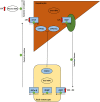Chorioamnionitis induces hepatic inflammation and time-dependent changes of the enterohepatic circulation in the ovine fetus
- PMID: 33990635
- PMCID: PMC8121927
- DOI: 10.1038/s41598-021-89542-4
Chorioamnionitis induces hepatic inflammation and time-dependent changes of the enterohepatic circulation in the ovine fetus
Abstract
Chorioamnionitis, inflammation of fetal membranes, is an important cause of preterm birth and a risk factor for the development of adverse neonatal outcomes including sepsis and intestinal pathologies. Intestinal bile acids (BAs) accumulation and hepatic cytokine production are involved in adverse intestinal outcomes. These findings triggered us to study the liver and enterohepatic circulation (EHC) following intra-amniotic (IA) lipopolysaccharide (LPS) exposure. An ovine chorioamnionitis model was used in which circulatory cytokines and outcomes of the liver and EHC of preterm lambs were longitudinally assessed following IA administration of 10 mg LPS at 5, 12 or 24h or 2, 4, 8 or 15d before preterm birth. Hepatic inflammation was observed, characterized by increased hepatic cytokine mRNA levels (5h - 2d post IA LPS exposure) and increased erythropoietic clusters (at 8 and 15 days post IA LPS exposure). Besides, 12h after IA LPS exposure, plasma BA levels were increased, whereas gene expression levels of several hepatic BA transporters were decreased. Initial EHC alterations normalized over time. Concluding, IA LPS exposure induces significant time-dependent changes in the fetal liver and EHC. These chorioamnionitis induced changes have potential postnatal consequences and the duration of IA LPS exposure might be essential herein.
Conflict of interest statement
The authors declare no competing interests.
Figures









References
Publication types
MeSH terms
Substances
LinkOut - more resources
Full Text Sources
Other Literature Sources
Medical

